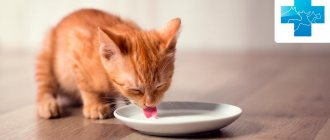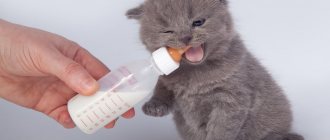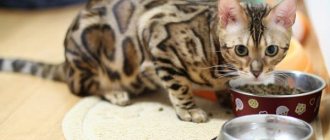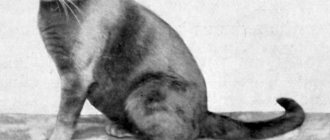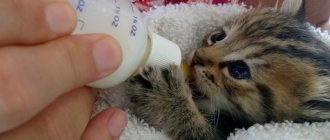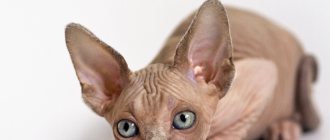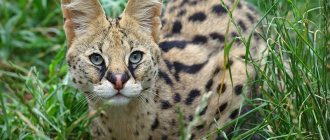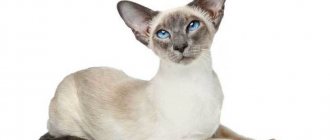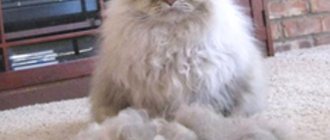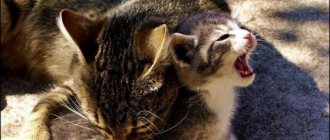The British are real beauties, this breed cannot be confused with any other. The British Shorthair cat is a strong, beautiful and well-proportioned animal with silky fur, regal bearing and expressive eyes. Today, representatives of this breed are the pride of the United Kingdom and are popular all over the world.
Caring for British kittens
The mother will teach the baby the first hygiene skills.
Further, taking care of the appearance and health of the baby rests with family members. Necessary procedures:
Cleansing ears and eyes. The condition of the hearing and vision organs is monitored weekly: they are cleaned of dirt and pus. Why British kittens have watery eyes up to 5 months old and how to help them, a doctor at any veterinary clinic will explain. With the process of improving the respiratory system, this unpleasant phenomenon disappears. You should blot your eyes with moistened cotton swabs. Combing the fur coat. During the cold season, babies are brushed every week. In summer as needed. Purchase a special metal comb for combing out wool and undercoat. Kittens and older pets usually enjoy the procedure. There is not always time for combing: they find an arch comb. The cat will come up to the arc and scratch its fur. Manicure
It is not necessary to take it to the salon; the owner will be able to carefully, carefully, trying not to injure the animal, trim the claw. Start with nail care from 3 months, repeat once every 2 weeks
You need to pick up miniature scissors. Bathing the pet. Water procedures are resorted to as the British fur gets dirty. Anti-parasitic agents are also washed off from the hair after treatment. Not all babies love water; sometimes you can get by with dry shampoo.
What to buy
It is necessary to prepare for the arrival of your pet in advance. List of necessary things:
- litter tray, device with low sides. In the future, you can change it to a deeper container so that the cat does not scatter the litter throughout the house;
- scratches, a scratching post is necessary for both the cat and the owner. To prevent the baby from ruining the surface of the furniture, they teach him how to use the item. They sell cool designs with balls;
- toys, for the development and prevention of obesity, the pet needs to actively move: balls, mice, houses with hanging balls, hammocks.
- utensils for eating and drinking.
Determining the age of a fold-eared kitten
| Way | Sign | Age |
| External signs | Umbilical cord | A few days |
| Open eyes | At least a week | |
| Open ear canals | 5-8 days | |
| Erupting incisors | 2-3 weeks | |
| The eyes have opened, but not completely yet | 2-3 weeks | |
| Milk fangs | 3-4 weeks | |
| Changing eye color | 6-7 weeks | |
| All baby teeth | 4 months | |
| All molars | 7 months | |
| Behavioral signs | The kitten starts to walk | 2-3 weeks |
| The kitten can roll over in the air | 3-4 weeks | |
| Responsive to outside noise | 3.5 weeks | |
| Kitten running | 5 weeks | |
| The cat does not feed the kitten | 7 weeks | |
| Signs of puberty | Loud meowing, attempts to run away from home | 4 months |
| Males mark territory | 4 months | |
| First heat in females | 4-6 months | |
| Attacking other kittens to establish dominance | 7 months |
Characteristics of the Scottish Fold cat breed
Important! At 7-8 months, the kitten should pay special attention, since it is at this time that it socializes and gets used to the company of people.
Source
Basic rules for feeding British cats
If your pet is on ready-made food, then you can no longer feed it any natural food. Ready-made feed should be purchased exclusively at pet stores. There is no difference between dry and wet products, they differ only in the amount of liquid. Of course, if you give your animal dry food, then it is necessary that there is a bowl of water next to the bowl.
All feeds are divided into three large groups:
- super premium;
- premium;
- economy
The difference between them is primarily in balance. Also sometimes there are holistic foods - food prepared entirely from natural products, which, in principle, can be classified as super premium class. There is no particular difference between representatives of the same group.
All holistic foods, as well as premium and super premium food, are already balanced. Therefore, there is no need to give your cat additional vitamins. Any additives can be added to the diet only after consultation with a veterinarian. Cheap vitamins will not give any effect; they are more suitable as a treat.
Each package contains tables showing how much product should be given to the animal. These recommendations must be followed. You can feed both dry and wet food at the same time, but only if they are products from the same manufacturer. Of course, you need to monitor the pet’s condition and its weight.
It is not advisable to switch from one food to another. This is unnecessary stress for the animal.
If you do switch, it is advisable to finish the old package, since in this case the company will be able to guarantee that there is a balance of all vitamins according to the labels on the package. Don't keep food in a bowl. The fact is that many vitamins are destroyed by oxygen (a strong oxidizing agent). If the animal has not finished eating, the product is poured back into the packaging and the plate is removed.
When analyzing the composition of the feed, you need to pay attention to the following parameters:
- Number of types of meat. The more there are, the better the balance of proteins, fats, amino acids and other nutrients. Usually the complex includes chicken or fish. It will be excellent if the food includes rabbit, turkey, and beef. Premium food must contain 2 sources of meat.
- The order in which the ingredients are listed. It is prescribed depending on the ratio of the product in the feed. The ingredient that has the largest share (by weight) is listed first. This means that it is desirable that meat should be listed first in the composition.
- Soy. It shouldn't exist at all. Firstly, soy products are poorer in amino acids and vitamins. Secondly, many animals are allergic to it.
- Cereals. They are rich in carbohydrates, which is very good for humans, but bad for cats. These predators in the wild never ate cereals and bread. Therefore, it is desirable that these ingredients are absent from the food.
- Other Ingredients. But it will be useful if the complex includes a variety of vegetables, sprouts and plant seeds, and vitamin and mineral complexes.
- Preservatives, dyes and flavors. They shouldn't exist either.
- Offal. They are usually used in economy class meals. Some feeds allow the use of liver, heart, kidneys, tripe, bones and other meat by-products. Their nutritional value is lower, but it is still better than grains.
What to feed a British cat
The best food for a British kitten
Feeding British kittens
If you are going to feed your pet dry ready-made granules, then check out the rating of the 10 best foods for British cats. Among them, the best holistic ones would be Acana, Almo Nature, GO, Now and Barking Heads. Super premium class products can be considered just as good: “Pronature Original”, “Gina”, “Bozita” and “1st Choice”. The representative of the premium group “Royal Canin for British Shorthairs” is quite good.
Health
Newborn British kittens gain good immunity by being close to their mother for a long time. Within two weeks, their first teeth appear. You need to make sure that there is no inflammation of the gums.
Before vaccination, deworming must be carried out 10 days. Adult animals need to be given deworming medicine once every 3 months, especially if they go outside.
Although the British kitten is in good health, once you decide to have a baby, be prepared to pay attention to warning signs. If the cat constantly meows, is lethargic, and does not eat anything, then something is bothering her, but you should not make a diagnosis yourself. A veterinarian is qualified to identify diseases and treatments.
Kitten at birth
Newborn “British” babies are blind and deaf - their eyes and ears are still closed. Babies do not know how to regulate their body temperature and are completely helpless: their hair has no undercoat, which is why it does not warm them up at all.
Kittens do not walk and practically do not crawl - their legs are too weak. The bone frame is still very fragile, so babies are not picked up so as not to injure them. Human concern is to control the weight of the cat's offspring and create favorable conditions: a clean, warm nest, dim lighting, absence of noise and drafts.
Babies sleep most of the day. They wake up only to eat. They have a surprisingly well-developed sense of smell and touch, so the “British” easily find their mother in their “nest” - by smell, by touch.
The main stages of baby development in the first days:
- 3-4 days – the umbilical cord falls off.
- 4-5 – beginning of hearing formation.
The nutrition of “babies” is completely limited to cat’s milk and colostrum, rich in antibody elements that form strong immunity in the offspring.
In order for kittens to grow up healthy and strong, complete, timely nutrition of the mother is important at the “milk” stage.
The cat completely regulates the processes of defecation of the offspring: massages the tummies, licks the excrement. For the mother herself, a tray is set up next to the “family home”.
In the photo, video – a newborn “British”:
Kitten 1 month
The period of appearance of bear-type kittens. Month-old kittens are formed unevenly; a large body on short thick legs reminds us of a small bear. They sleep 16–20 hours, are very active, and play a lot.
Month-old kittens drink water on their own for 4 weeks, many eat wet and dry food themselves, and go to the litter box. Time to work with the kitten and adapt to the hands, teaching manners. The “change of color” of the eyes from blue to orange (for blue color), this happens gradually.
5 – 6 weeks | After 1.5 months, the kitten licks its fur and washes itself, the undercoat thickens, and the color becomes brighter.
At 7–8 weeks, babies are still drinking their mother’s milk and learning cat wisdom from her. The eyes acquired their color, became bright and clear.
What to feed a British kitten at 2 months?
When the little British cat has already reached 2 months of age, his character begins to form and he constantly plays, jumps, and runs. This is normal, this is how kittens develop. What to feed a 2 month old British kitten? The number of meals, in order for a beautiful, healthy and cheerful cat to grow up, needs to be increased to 7-8 times, if, of course, there is such an opportunity. Milk is still a necessary part of the diet, 2-3 meals are pure milk for kittens, no need to mix it with other products.
As for other meals, in addition to milk, milk porridge, scraped beef, cream and cottage cheese, it is time to introduce canned food for kittens. What to feed a British kitten at 2 months? Below are the permitted foods and their ratios in the diet based on 7 meals a day:
- milk for kittens - 2 meals - 25% of the diet, best in the morning and in the middle of the day (1 meal and 5);
- cream - 1 meal combined with milk porridge - 6-7% of the diet, in the afternoon (4th meal);
- cottage cheese - 1 full meal - 12-13% of the diet, in the first half of the day, but not immediately after milk (3rd meal);
- milk porridge - 3 doses - 31-32% of the diet, morning, lunch and evening (2, 4 and 6 doses);
- canned food for kittens and scraped beef - 1 dose, 50/50, but sequentially, first one, then the other, before bed, so that you can sleep soundly (7 meals).
The main points on how to feed a British kitten at 2 months are given. You should also be attentive to your pet; there may be individual intolerance to a particular product, as well as individual developmental characteristics. For example, if the kitten still refuses to eat certain foods, it may be necessary to shift the start of feeding according to the scheme of the second month a week ahead.
British newborns, what they look like, photos
Outdoor cats choose dark, warm places to give birth, usually basements and attics. At home, you need to provide a “birther” for the British woman. It can be made from a large box, 60x60 cm in size, 40 - 50 cm high. Store banana boxes and exhibition tents are suitable. Lay out a diaper for animals and a heating pad.
Depending on the number of kittens in the cat’s womb, a newborn kitten can have a body length of 8 - 12 cm, the weight of kittens is from 70 - 120 g, there are small ones of 50 - 60 g, this happens when there is a multiple pregnancy. Weight table here.
The British are born blind, deaf, with large claws, without undercoat, the fur is not able to warm the baby, so you need to monitor the temperature of the “birthing place” ≈ 38 - 39 C⁰. At the age when kittens sleep 95% of the time, their innate sense of smell and touch allows them to find the cat's nursing nipple. The British mother licks the kittens; without her, they are unable to defecate. In the period from birth to 2 - 3 weeks, you should monitor the daily weight gain of babies by 10 - 20 grams, they should be weighed in the morning at the same time. If someone does not finish eating, then put it on the nipple more often.
Stages of development of a newborn British baby by day:
- Days 1 – 3 – baby sleeps, eats; how to determine the sex of newborn kittens is described in detail here
Plush kittens at 1 week
During this period, babies begin to crawl more actively, and many begin to open their eyes. Children's undercoat is formed and they react more actively to sounds.
It's time to increase the area for cats, choose a name.
Video of the British in 10 days below.
Little kitties 2 weeks old
British Shorthairs grow quickly, their weight has tripled since birth. They began to sleep less, eat less often, but the portions became larger. They begin to walk unsteadily, with long claws allowing them to maintain balance. By the end of the second week, the eyes open, they will immediately be a little cloudy. The first eye color is blue. They are seen a couple of days after opening on days 14–17. They hear the cat better and respond to its purring.
British 3 weeks
Kitties see and hear everything, sit and walk confidently, and try to jump. Baby teeth are visible. They are very curious and try to get out of their beds, so it is worth using fences and playpens. The area for children to play should be increased. Provide a scratching post, soft toys, a tray with filler and water.
The cubs actively play with each other, bite and hiss, and practice hunting skills.
What a British cat shouldn't eat
It is also important to understand what you absolutely cannot feed an animal:
- Low quality dry food like Whiskas, Friskas, Kitiket. They, of course, are not as expensive as premium products, but such savings will not bring benefits. The composition speaks for itself - horns, hooves, feathers, aromatic additives.
- Food from the master's table. By the way, this is a common mistake of many owners who lovingly feed furry beggars borscht, cutlets, canned food, and sausages.
- Although meat is very good to include in the diet, not all types are equally healthy. Thus, fatty varieties are strictly contraindicated. For example, lamb.
- Under no circumstances should you feed salty, spicy, smoked or sweet foods! Spices are also not welcome.
- Vegetables and fruits are recommended for furry pets, but not all. Eggplants, for example, are even recognized by veterinarians as dangerous to cat health. Just like onions, garlic, potatoes, citrus fruits.
- It is theoretically possible to eat river fish, but in reality there is a high risk of small bones getting into your pet’s body.
What to prepare for the kitten's arrival
If the choice of the future pet has already been made, all that remains is to wait until it grows a little and can leave the nursery. It is necessary to prepare and foresee a lot for his arrival.
First of all, buy:
- carrying;
- a house or bed for sleeping;
- scratching post;
- bowls and food containers;
- dry and wet food;
- litter tray;
- filler;
- toys;
- accessories and grooming products.
Carrying
Carrying is necessary for safe transportation. They will not allow you to pick up an animal from a professional nursery in her absence. Moreover, this item will come in handy more than once in the future - when traveling to the veterinarian, to the country, or on vacation to another city or country.
Pet stores now offer a large selection of carriers of different sizes and from a variety of materials - rag, in the form of bags made of leatherette and plastic.
The latter option is preferable, as it has a large internal volume, rigid and durable walls, and retains its shape. If in the future it is possible to fly with your pet on an airplane, then you need to choose exactly this model, since airlines have special requirements for the luggage container.
It’s better to immediately choose a fairly expensive carrier, with a metal door and strong fastenings. You should not buy a small one, the baby will grow within a year, and adult British cats can reach a weight of six kilograms. Estimated price - 2-3 thousand rubles.
At first, with the door removed, the plastic carrier can also serve as a place to sleep.
Cat house and scratching post
In specialized stores, you can choose an option that will suit everyone - it will suit your pet in size and fit well into the interior of the house. There are many options for cat houses.
The most convenient one for a Briton is a small one on a round stand, which also serves as a scratching post. This breed is not very active and large play structures will not attract the kitten's attention.
The preferred upholstery option for the house is carpet; it washes best and lasts longer. The rope on the scratching post should preferably be jute. Although at first there will be a little garbage from it, any cats give it preference over other options and willingly sharpen their claws.
This design can be purchased for 4 thousand rubles.
You can get by with a bed, but this is a less convenient option. It wears out faster and requires frequent washing. The minimum cost is 1000 rubles. And in this case you will have to buy a scratching post separately. A small corner corner made of carpet will also not cost less than a thousand. But it quickly breaks down, and kittens are not too fond of such material.
Bowls and food containers
Among the huge variety of cat dishes, you should choose one that is comfortable for your pet and made from safe materials. This is stainless metal and earthenware.
A double bowl on an adjustable stand for water and dry food is very practical. You can buy a separate earthenware plate for wet and natural food. All three will cost 1-1.5 thousand rubles if chosen correctly.
The height-adjustable stand is very convenient - for a kitten you can lower the bowls to the lowest level, for an adult cat you can raise them. This accessory is pet-friendly and stable - it won't slide on the floor when the animal is eating.
A small container for food is also desirable; you can pour dry mixture (0.5-1 kg) into it and always keep it in the kitchen. It is usually made of metal and beautifully designed. This accessory is inexpensive - from 200 rubles.
Stern
First of all, you need to ask the breeder what kind of diet the British baby had in the nursery. For the first time, it is necessary to purchase exactly the food that the kitten is accustomed to.
If the desire arises, you can gradually transfer it to another, but not in the first days after the move.
Several bags of high-quality wet food are also necessary, even if you do not feed them to the animal in the future. In the first days at home, the baby will experience stress and may refuse to eat. This delicacy usually creates an appetite.
The cost of super premium food starts from about 500 rubles per 1 kg.
Toilet and litter
The acquisition of these important items must be taken seriously. First of all, find out from the breeder what kind of toilet and litter the British kitten uses in the nursery.
Experienced breeders never set up a separate small tray for babies; kittens, looking at their mother, begin to go to the same toilet as her.
Usually in nurseries they use closed toilets of the “house” type. They often consist of two compartments, one of which contains a grid for cleaning the paws. Such a toilet is not cheap and can cost about 5 thousand rubles, but it is made of high-quality plastic that is easy to clean, will never break and has bactericidal properties (with silver ion deposition).
They are usually equipped with special filters for air purification.
For small kittens, wood filler is preferable; most likely, this is what the baby is used to in the nursery. This is the most inexpensive and safest option. A 15 liter bag costs about 500 rubles.
Don't forget about a special scoop for cleaning the toilet.
Toys
Simply necessary in the house - balls, swings, mice made of natural fur, interactive ones. It is important that they are made of safe materials and do not have small parts that come loose. 1000 rubles are enough to purchase them. The missing ones can be easily made with your own hands from old clothes or a cardboard box.
Accessories and grooming products
A whole list of items is needed here:
- metal combs of two types - with a frequent and rare comb;
- massage brush for combing;
- nail clipper;
- lotions for the care of ears and eyes;
- shampoo for kittens;
- first aid kit;
- sprays for toilet training (you may need them at first).
These acquisitions will cost 2000-3000 rubles.
Ideal age to move
Many future owners want to monitor the growth and development of a British baby from an early period, at least from four weeks. But it is absolutely forbidden to take such a pet away from its mother.
By 12 weeks, a British kitten is more or less ready for independent living. It is at this age that the baby stops sucking mother’s milk, learns to eat solid food, and his own immunity begins to develop.
It is the mother who must do the weaning. If this procedure is carried out forcibly, then, in addition to health problems, behavioral disorders will certainly arise. Early weaning is also fraught with the development of diseases of the respiratory system, diarrhea and, as a result, dehydration.
Both vaccinations against panleukopenia, calcivirus and rhinotracheitis have already been carried out, which means the baby has immunity to these diseases.
The kitten is physically strong enough to move. At two or three months he received from his mother the skills of using a litter tray.
When parting with its mother early, the emotional state of a British kitten suffers greatly, since it is she who teaches how to communicate with people and other animals. A three- to four-month-old baby perceives new faces not with fear, but with curiosity. Therefore, it is worth listening to the opinion of the breeder and picking up a British kitten from the nursery at 12, and sometimes at 16 weeks.
First meeting
Like most similar babies, including Maine Coon kittens , before your arrival the little British were with their mother and brothers and sisters, they were accustomed to such an environment.
Once in your house, they find themselves in conditions that are alien to them, so at first they will be afraid of everything.
If your baby is hiding in a corner, do not try to force him out of there.
The article https://kot-pes.com/kak-poymat-kota-v-lovushku/ will tell you how to catch a cat in a trap.
If you really don’t like the place he has chosen, be smart and lure the cat out with a toy; in the excitement the kitty will forget about stress.
A British kitten carefully studies a parrot to understand whether to be friends with it or hunt it
Immediately show your British baby his food and water bowls, his sleeping place and his litter tray, which has not only been filled with fresh litter, but also a handful of what was in his old potty.
Do not let the kitten walk around the entire apartment on the first day. Firstly, there is a possibility that he will get lost and again, out of fear, will hide in another corner.
Secondly, the kitty may not reach the tray and relieve itself on the way to it.
After a few days, when the new family member has completely settled in, you can open the doors of all rooms for him.
However, the gray-blue color of British kittens sometimes allows them to blend into the carpet, so watch your step carefully.
British kittens know how to properly care for indoor plants
Diet depends on age
In order for the little Briton to develop properly, new food should be gradually introduced into his menu. The most important period is 2-6 months, when organs and systems are quickly formed, the age of active growth. But at this time the baby still does not know how to eat everything, and is not familiar with the taste and smell of many foods.
3 weeks
From the age of three weeks, the first acquaintance with food begins. Before this, it was completely accessible and easily digestible. There was no need to look for it, chew it or lap it up. Therefore, all new foods must be crushed so that the baby learns to eat properly. For a week, a small amount of meat, only finely chopped, is added to the mother's milk every day. The quantity increases gradually. Milk porridges are added to complementary foods, for which only goat's milk should be used. And be sure to follow the “one day, one new treat” rule.
British breed kitten
2-3 months
The problem of what to feed a British kitten arises 2 months after birth. At this time, babies gradually refuse mother's milk. It is during this period that it is time for the owner to decide whether his pet will receive natural food, or it is time to start getting acquainted with industrial food. In the first case, it is better not to offer new food - refusing the mother is already an innovation. In the second case, you can add special canned food that is age appropriate to your baby’s menu. Do not use dry food right away.
While the baby is still sucking milk, complementary foods should be given more often and in small portions - up to eight times a day, so that the digestive system adapts to new conditions.
British kittens eat
The sooner natural feeding is abandoned, the more varied a British kitten can be fed: at 3 months, new types of complementary foods are possible. However, you still need to feed more often - at least six times a day. By the end of the third month, you can reduce the number of meals to five. At this time, poultry meat (chicken is best), offal, vegetables and fruits, egg yolk, sea fish (boiled and boneless), fermented milk products are added as complementary foods.
For animals whose diet is planned to be based on industrial food, it’s time to gradually add preserves (be sure to pay attention to the recommendations given on the packaging) and softened dry food. You can also use canned baby meat
5-6 months
At this time, the main emphasis is on reducing the number of feedings per day - up to four times. There should be few new products: for kittens on a natural diet - low-fat cheeses; for babies on industrial food, the dilution of dry products is gradually reduced. This process lasts up to a year and the percentage is brought to 70% of dry food per day.
Feeding a British baby at 4 months
At the fourth month of life, the fold-eared purebred cat is already a fully formed animal, with beautiful shiny fur and adult behavior. It has already increased significantly in size, its weight exceeds its original parameters by about three times. At this age, you can safely add special dry food for British kittens to your diet. The number of feedings is reduced, and the dosage of portions is increased.
The main menu continues to be dominated by products acceptable for feeding kittens 3 months of age. Approximately 25-30% of the total diet consists of dry food. During this period, the owner needs to decide on the manufacturer of cat food, giving preference to proven brands. You can consult your veterinarian on this issue, not forgetting to take into account personal observations of your furry pet.
High-quality food is sold at a higher price, but this is not a reason to save on the health of your new friend. You should not buy food for your domestic cat in dubious places; it is better to purchase nutritious products from pet stores that are certified for animal products.
Breeders do not recommend purchasing feed in bulk at local markets. The quality of such products is very questionable, which means that feeding these compounds can negatively affect the health of the animal.
What to feed a kitten if it is poisoned?
What to feed a British kitten at 3 months?
Nutrition may vary depending on the breed of kitten. In particular, British cats are more demanding of natural food. It is recommended to feed the kitten up to 6 times a day, but in small portions. This diet can be maintained for up to six months. What to feed a British kitten at 3 months so that he grows up active and cheerful? First of all, your pet's diet should contain large amounts of protein products. Preference is given to beef and poultry. You can include chicken by-products in your baby’s menu 2 times a week:
- kidneys – add as puree;
- heart - given boiled;
- light - boiled, finely chopped and added to the main dish or served on its own;
- liver – this product should not be overused; it is enough to introduce it into the kitten’s diet 3 times a month.
Not all breeders know what to feed a 3-month-old British kitten. The best product is considered to be veal or beef. Meat can be given raw, having been pre-frozen to prevent parasites from entering the baby’s body. Vegetables should be included in your pet's diet. Preference is given to cauliflower, which is boiled and chopped. You can also diversify your pet’s menu with carrot or asparagus puree.
It is recommended to give kittens rice porridge. Rice helps normalize digestion. Semolina is less useful, although it can also be included in your pet’s diet. Oatmeal porridge is healthy. They can be cooked with water or milk.
- If necessary, porridges can be slightly salted, but remember that the British should not eat too salty food. The same goes for sugar and spices. They should be excluded from the baby's diet.
- It is not advisable to give your Briton potato broths and mashed potatoes. This product is poorly digestible and does not provide any benefit to the baby.
- It is not always possible to choose natural food with a full range of vitamins and minerals. The British are recommended to take special supplements to compensate for the deficiency of essential minerals.
- Your pet's food should be warm and fresh. You can offer sprouted millet or wheat grains as a treat.
- If you can’t feed your kitten natural products, you can use canned food for cats.
What to feed a Scottish kitten for 3 months?
The diet of Scots is not too different from the diet of an ordinary kitten, although there are some subtleties here too. Representatives of this breed especially need products containing vitamin B, which is found in cereals, rabbit meat, liver and egg yolk.
The question may arise: what to feed a Scottish kitten for 3 months if it has just been separated from its mother. At the initial stage, low-fat kefir and cottage cheese can be included in the baby’s diet in large quantities. Gradually the pet is transferred to meat food. The Scotsman requires fats of vegetable origin. You can replenish their deficiency by adding 1-2 drops of vegetable oil to prepared food. This should be done daily, but not with every meal. The pet's basic menu can be porridge with meat. The ratio of cereals and minced meat should be 1:1. You can also add mashed chicken yolk or quail egg there.
It is advisable to add chicken stomachs, beef udders, and chicken necks to your pet’s diet. All products are passed through a meat grinder.
You can introduce lamb into your pet's diet, however, you should remember that this meat is high in fat, and therefore its amount in the pet's diet should be limited.
Cats love cucumbers and melon, but these foods should not be given in large quantities. Especially melon due to the high amount of carbohydrates. You should also limit your fish consumption. If your pet loves fish products, then you can cook him porridge with fish broth.
The daily portion of a kitten aged 3 months should not exceed 150 g.
Pork should be completely excluded from the kitten's diet.
A mixed diet using ready-made feed and natural supplements is acceptable.
What do you feed a kitten at 3 months? Share your experience on .
Preparation
The preparation includes several stages:
1. Explain to children how to properly handle a British baby.
It must be made clear that a kitten is not a toy that can be constantly carried in your arms, dragged by its tail or paws, and so on.
Children should learn that the British Blue kitten needs to be left undisturbed when he goes into his house, eats, or goes to the toilet .
2. Solve organizational issues: where the cat will eat, go to the toilet and sleep.
At first glance it seems that this is not so difficult. However, cats in general, and the British in particular, are conservative animals.
You can learn how to make a cat bed with your own hands from the article
In matters such as the location of familiar places, they do not like change.
Therefore, the selected corners should be assigned to the animal, if possible, for its entire life. There should be a scratching post .
Mrr, I haven’t done any mischief here yet
3. Purchase the necessary items for the cat. This includes:
- tray, also known as toilet;
- filler , at least it will be necessary at first;
- cat house - you can make it yourself, then you need to take care of suitable materials;
- a carrier, it will also come in handy when the baby grows up to transport the animal, for example, to the veterinarian or to the country;
- toys, like a house, you can make them yourself, which means we care about the safety of materials;
Stylish house for a British cat
- bowls for water and food; You don’t have to buy something special, but use durable ceramic bowls, but it is important that their inner side is completely smooth, without cavities into which food can get stuck and mold there;
- nail clipper;
- cotton buds;
- shampoo for short-haired cats;
- repellent spray – just in case, to prevent bad habits from developing, we’ll talk about them in more detail later.
This article will tell you how to properly make a house for a cat with your own hands.
Sample menu by age
The nutrition of kittens changes as they grow, so the owner needs to know an approximate menu by age. The list of products in it is conditional, it is allowed to diversify it, which will benefit the pet.
Up to a month
Up to a month, kittens are usually fed by the mother with her colostrum and milk. She calculates the frequency of feeding herself for her offspring. The secretion of the mammary glands is the most suitable food for newborn kittens. It contains everything you need to create strong immunity.
Sometimes the mother cannot or refuses to feed the cubs. Then the owner will have to fatten the pets. For this purpose, a cat's milk replacer is used. The number of feedings and method of breeding are indicated on the packaging. Usually replacements are given for up to 4 weeks.
1 month
When the kitten is 1 month old, it is advisable to continue feeding it with mother's milk. If this is not possible, then a high-quality substitute. Then there is a smooth transition to solid food.
Basic Rules:
- Start introducing dairy products into your diet, but raw cow's milk is not recommended. The best option is infant formula.
- Include meat in your diet with boiled finely chopped beef or, better yet, veal.
- Gradually include porridge made from buckwheat, semolina or oatmeal.
- At the end of the first month, introduce fermented milk products: cottage cheese, yogurt.
- Give boiled liver 1-2 times a week.
Menstruating Britons eat often, but in small portions. The size of one is 30 grams. Daily amount – 5–6 times. Kittens themselves will tell you what and how much they are ready to eat, so it is recommended to focus on their preferences.
2 months
At 2 months the diet is finally formed, and the kitten begins to move a lot. Activity leads to increased energy consumption, so you can feed your pet more often - up to 8 times a day. Portion sizes remain the same as for one-month-old kittens.
The diet consists of milk porridge, cottage cheese, boiled lean meat, and egg yolks. Infant formula can remain at this age. If a mixed diet was chosen, then wet kitten food is included.
3 months
The kitten is gradually growing, so you can introduce new foods to the diet for variety.
Nutrition for 3 months:
- sea fish (boneless fillet);
- boiled vegetables mixed with chopped meat (beef, chicken, turkey);
- homemade fermented milk products that replace infant formula;
- dry granules soaked in milk or water.
The number of meals is 4–5, the size of each serving increases to 40–50 grams.
4–6 months
The diet at 4–6 months is characterized by an increase in dry food. The number of servings is reduced to 4 by six months, and the sizes become larger - up to 70–80 grams. One meal of food should consist only of dry granules. The remaining products remain (meat, vegetables, cereals, yolks, liver).
From 6 months to 1 year
The age from 6 months to 1 year is a difficult period for the owner. The kitten is finally formed and begins to show character. At this time, nutrition plays an important role.
It will only harm your digestion. Gradually, as the year progresses, the amount of dry food in the daily diet increases. Meals first become three times a day, and then two times a day for adult cats. Portions also become larger accordingly.
Power change
If you suddenly change the diet, you can get diarrhea in a kitten at 4 months. Therefore, you should not risk the life and health of a Briton by rushing to switch to another type of food, but gradually introduce him to food. Gradually increase the amount of new food when you feed your baby, while decreasing the amount of old food.
A meat diet is a bad option, so do not give your pet only meat at 4 months. Although they are considered carnivores, they remain omnivores, eating both meat and vegetables equally. Therefore, the diet must be balanced.
Nutrition for British kittens, cats, cats: prohibited foods for the British
Prohibited foods for feeding British cats (British kittens, cats, cats) should be remembered and avoid feeding the animal with them. This can lead to serious consequences!
Can Brits eat fish?
Can Brits eat fish? – You can, but only boiled seafood and definitely fillet.
River fish themselves live in a not very clean environment, and for a purebred British kitten this can be critical. Be sure to boil the fish, because... we don’t know where it was lying, what hands touched it and what else it might contain. After keeping it in boiling water for 10 minutes, you can safely give it to the kitten. Be sure to remove any bones; fish bones are quite sharp and can injure your pet.
Can a British kitten have milk?
Can a British kitten have milk? – It’s also possible, but only up to six months. It is not recommended to continue giving milk, as it is poorly digested in cats. It is better for the British to replace milk with fermented milk products.
What not to feed a British kitten:
- fresh meat;
- pork is too fatty meat, difficult for cats to digest, pork contains bacteria harmful to cats;
- river fish - very sharp and small bones;
- milk after 6 months of age is not tolerated by the stomach of cats;
- onions (in any form) are toxic to cats;
- sweet;
- salted/smoked;
- dry food/canned food/preserved food from Whiskas, KiteKat, Friskies (this is the same as if we ate chips every day - it’s tasty for them, but very harmful; all types of food are made from second-rate products of the lowest quality).
Newborn fold kittens
Folding ears are associated with the specific structure of the ears. This property was recorded in Scotland in 1961, when breeders began to deliberately breed lop-eared kittens. Hence the second name of this breed – Scottish.
Scientists have discovered that this ear structure is a gene mutation, with lop ears being a dominant gene. When two fold-eared cats are crossed, weak kittens are born. In order for the offspring to be healthy, one parent must have fold ears, and the other must have straight ears. When purchasing, find out which cats your future pet comes from. This will save you from choosing a purebred but sick kitten.
Newborn fold kittens
Kittens in a litter from a fold-eared parent and a straight-eared parent are different, but they can be distinguished from each other after 2-3 weeks.
British and Scottish ears
Important! It is recommended to buy a fold kitten when it is 6 weeks old. At earlier stages, you risk paying a large sum and finding that the kitten's ears will straighten over time.
How to distinguish a British kitten
How to identify a British kitten among others can be determined by its incredible plush fur coat. Their fur, unlike that of an ordinary baby, is very thick, soft, shiny, and sticks out a little like a hedgehog.
Pedigree purebred British kittens have a compact, muscular body with a wide chest. You can identify the British breed by their short, plump legs and thick, small tail.
The distinctive features of such a kitten are cute, wide-open round eyes, prominent cheeks and a Cheshire cat smile. You can determine what a purebred cub looks like by its color. The British have a lot of types of colors, including plain and tabby. The breed standard has strict requirements for each color.
External signs of lop ears
A fold-eared kitten has structural features of the entire body, and not just the ears. These include:
- The nose is without humps, which can be determined by touch.
- The tail is smooth, without humps or knots.
- Wide muzzle.
- Round head.
- Small cheeks.
- Wide eye set.
- Large chest.
- The legs and tail are shorter and larger than those of their straight-eared counterparts.
- Plush wool.
External signs of fold-eared cats
Interesting! Fold cats are long-haired - Highland Folds, and short-haired - Scottish Folds.
Types of British and Scottish cats
About the breed
The breed standard dictates the picture of the external characteristics of the animal. What does a British kitten look like: round cheeks, straight ears, a powerful body with a large chest, strong legs and elastic, dense fur. The baby's tail is fluffy, with thick hair. Kittens differ in hair volume, color, origin, and the presence or absence of titled parents.
| Capabilities | ✓✓✓ |
| Playfulness | ✓✓ |
| Health | ✓✓✓✓ |
| Hair loss | ✓✓✓ |
| Difficulty of care | ✓✓✓ |
| Relationship with other pets | ✓✓✓ |
| Reaction to strangers | ✓✓✓✓ |
| Attachment to family members | ✓✓✓✓✓ |
Cubs are divided into three main types:
- Long-haired.
- Short-haired.
- Lop-eared.
Longhair
British longhair kittens were obtained after mating a British shorthair with a Persian cat. At first, producers considered this breed category a defect: they did not want to spoil the short-haired appearance. But later the popularity of those with softer hair began to grow. A new breed of British pet has emerged.
Shorthair
British Shorthair cats are a strong, muscular variant with short, plush fur and a thick undercoat.
British kittens photos
Colors
Usually the color is indicated in the advertisements. It is difficult to determine the color: nursery owners exhibit small British dogs in photographs. The most common options:
- tabby;
- color point;
- marble (whiskey);
- whiskey (marble);
- tortoiseshell;
- blue;
- black;
- white;
- grey;
- ginger;
- lilac;
- chocolate;
- silver;
- red;
- peach;
- beige;
- cinnamon;
- ticked;
- harlequin;
- brown.
Loss of characteristic: when the ears rise
Straight-eared kittens are called straights, and fold-eared kittens are called folds. The clear difference between them lies in the presence and number of folds on the ears. One fold causes the ears to straighten over time. This does not mean that the kitten is straight. To answer the question about his breed, an examination is carried out. It is especially important for owners who plan to crossbreed kittens. An incorrect conclusion about the straightness of an animal leads to the crossing of two lop-eared individuals and sick offspring. If there are two folds, then it is impossible to predict the outcome: the kitten can remain fold-eared with the same success as become straight-eared. Three folds ensure the ears don't straighten out.
External differences between British and Scottish cats
Folds with erect ears are sterilized to prevent the transmission of a dominant gene that has lost visual expression.
There is a clear sign that distinguishes a fold-eared cat with erect ears from a straight-eared one: the size of the ears. The first one has smaller ones.
Temporary changes in the position of the ears are also possible, the cause of which is weather conditions. The heat causes the Fold's ears to rise slightly.
Important! To purchase fold-eared kittens, choose a time of year with moderate temperatures.
In addition, the ears of the folds also rise in females after giving birth.
Vaccinations
Do not forget that the British breed was bred almost artificially. Animals of this breed have weak immunity. Don't neglect vaccinations ! In fact, this is very important. Already in the period from two to three months, a kitten can be vaccinated. This will protect him from many diseases. Before visiting the veterinarian, give your pet an anthelmintic drug ten days in advance; if after ten days no helminths are found, then you can safely visit the veterinarian.
After the first vaccination, the second one is given, exactly twenty-one days later. The same vaccine is administered, and after fourteen days immunity is developed. Repeated vaccinations are recommended every year.
Features of breeding fold cats
If you want to try your hand at breeding purebred cats, then it’s better to start by studying in felinological courses, which teach the basics of genetics, veterinary medicine, and tell you about the rules for holding exhibitions and about international felinological organizations. Before organizing the mating of your pet, it is necessary that he take part in the exhibition. Even if the cat did not take a prize, it received a rating for its class, this could be:
- Pet class is an animal with a slight defect that cannot be used in breeding work.
- Breed class - full compliance with the breed standard and in good health for procreation.
- Show-class - not only compliance with the standard, but also a bright appearance, which allows you to receive prizes at exhibitions.
Only after receiving the class can your pet officially take part in the breeding work of the felinological club.
The difficulty in breeding fold cats lies in the correct selection of partners. Under no circumstances should fold-eared cats be mated with fold-eared cats. In such a mating, all offspring will have genetic diseases. In addition, the color of the animals is taken into account to obtain the best result.
It is advisable to breed young animals with more experienced partners at the age of about one and a half years (a cat during the third heat). To find a suitable partner, a felinological club is used and the act of mating is documented so that the kittens born have a correctly issued passport.
